Edinburgh Napier University: Nuclear Power Plant Thermodynamics Report
VerifiedAdded on 2023/04/10
|17
|2167
|315
Report
AI Summary
This report presents a thermodynamic analysis of a nuclear power plant, as outlined in the MEC10115 Advanced Energy Systems 2 coursework. It begins with an abstract summarizing the report's objectives, which include investigating the application of thermodynamics in nuclear power plant energy production, comparing its advantages and disadvantages to other power plants, and performing mathematical analyses of the thermodynamic processes. The main body includes a detailed analysis of the high and low-pressure turbines, determination of enthalpy, quality, and power output ratios, and a comparison of CO2 emissions across different power generation methods. The report applies the first and second laws of thermodynamics, plots state points on a TS chart, and calculates the plant's efficiency. It then discusses the merits and demerits of nuclear power plants concerning lifecycle values, CO2 emissions, decommissioning, and pollution. The report concludes with recommendations based on the analysis and a comprehensive list of references.

REPORT ON THERMODYNAMICS OF A NUCLEAR POWER PLANT
Paraphrase This Document
Need a fresh take? Get an instant paraphrase of this document with our AI Paraphraser
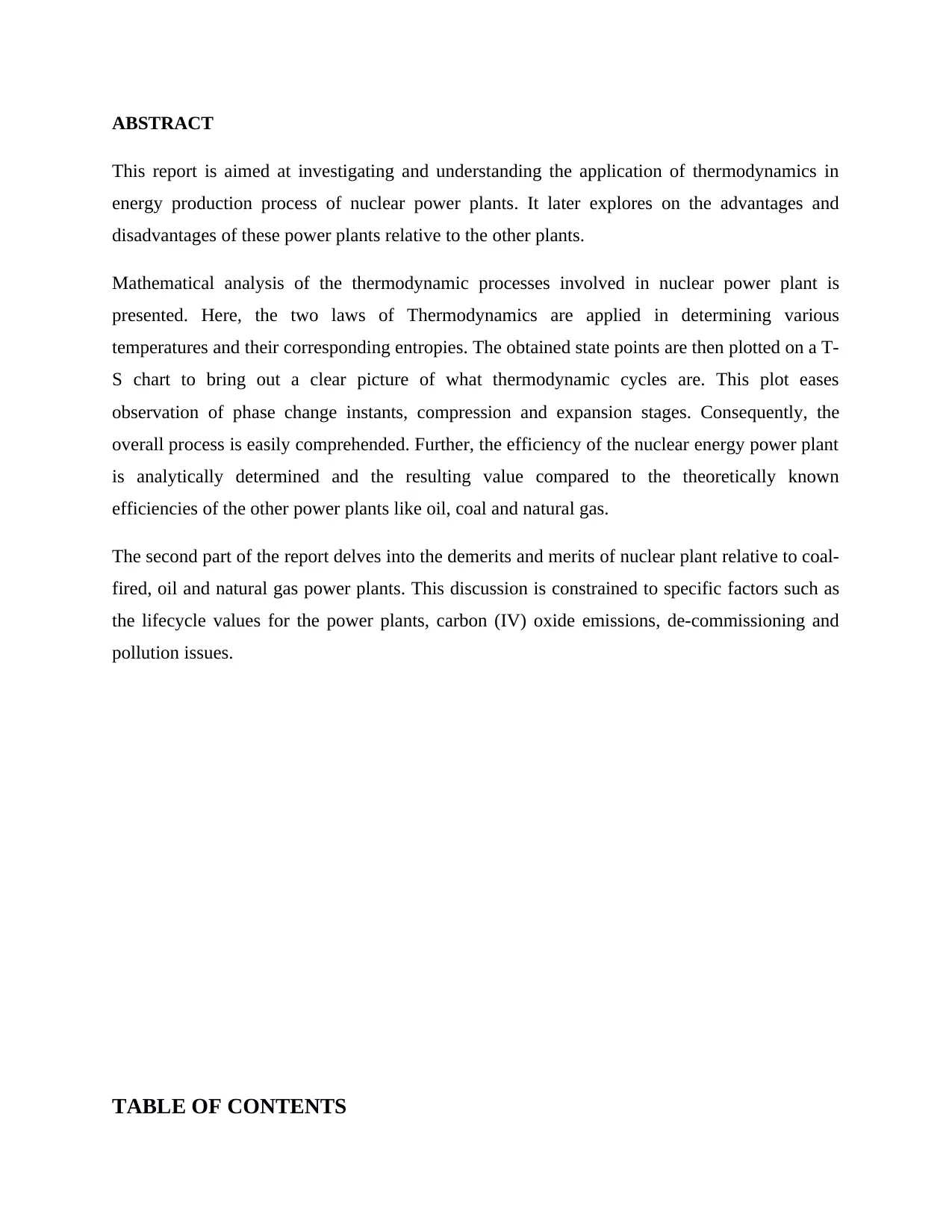
ABSTRACT
This report is aimed at investigating and understanding the application of thermodynamics in
energy production process of nuclear power plants. It later explores on the advantages and
disadvantages of these power plants relative to the other plants.
Mathematical analysis of the thermodynamic processes involved in nuclear power plant is
presented. Here, the two laws of Thermodynamics are applied in determining various
temperatures and their corresponding entropies. The obtained state points are then plotted on a T-
S chart to bring out a clear picture of what thermodynamic cycles are. This plot eases
observation of phase change instants, compression and expansion stages. Consequently, the
overall process is easily comprehended. Further, the efficiency of the nuclear energy power plant
is analytically determined and the resulting value compared to the theoretically known
efficiencies of the other power plants like oil, coal and natural gas.
The second part of the report delves into the demerits and merits of nuclear plant relative to coal-
fired, oil and natural gas power plants. This discussion is constrained to specific factors such as
the lifecycle values for the power plants, carbon (IV) oxide emissions, de-commissioning and
pollution issues.
TABLE OF CONTENTS
This report is aimed at investigating and understanding the application of thermodynamics in
energy production process of nuclear power plants. It later explores on the advantages and
disadvantages of these power plants relative to the other plants.
Mathematical analysis of the thermodynamic processes involved in nuclear power plant is
presented. Here, the two laws of Thermodynamics are applied in determining various
temperatures and their corresponding entropies. The obtained state points are then plotted on a T-
S chart to bring out a clear picture of what thermodynamic cycles are. This plot eases
observation of phase change instants, compression and expansion stages. Consequently, the
overall process is easily comprehended. Further, the efficiency of the nuclear energy power plant
is analytically determined and the resulting value compared to the theoretically known
efficiencies of the other power plants like oil, coal and natural gas.
The second part of the report delves into the demerits and merits of nuclear plant relative to coal-
fired, oil and natural gas power plants. This discussion is constrained to specific factors such as
the lifecycle values for the power plants, carbon (IV) oxide emissions, de-commissioning and
pollution issues.
TABLE OF CONTENTS

TABLE OF CONTENTS............................................................................................................................3
INTRODUCTION...................................................................................................................................4
MAIN BODY..........................................................................................................................................5
RECOMMENDATION AND CONCLUSION.....................................................................................13
REFERENCES......................................................................................................................................15
INTRODUCTION...................................................................................................................................4
MAIN BODY..........................................................................................................................................5
RECOMMENDATION AND CONCLUSION.....................................................................................13
REFERENCES......................................................................................................................................15
⊘ This is a preview!⊘
Do you want full access?
Subscribe today to unlock all pages.

Trusted by 1+ million students worldwide
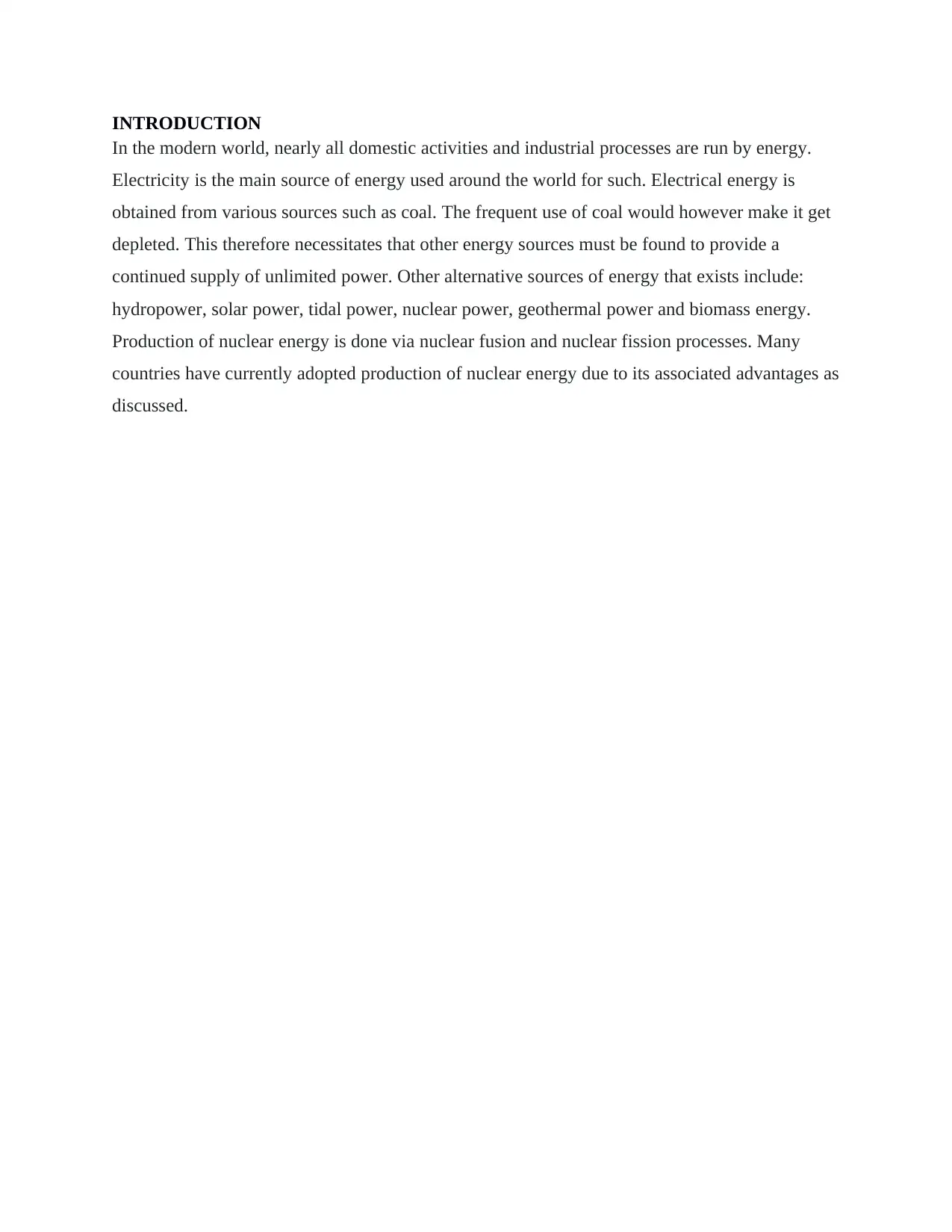
INTRODUCTION
In the modern world, nearly all domestic activities and industrial processes are run by energy.
Electricity is the main source of energy used around the world for such. Electrical energy is
obtained from various sources such as coal. The frequent use of coal would however make it get
depleted. This therefore necessitates that other energy sources must be found to provide a
continued supply of unlimited power. Other alternative sources of energy that exists include:
hydropower, solar power, tidal power, nuclear power, geothermal power and biomass energy.
Production of nuclear energy is done via nuclear fusion and nuclear fission processes. Many
countries have currently adopted production of nuclear energy due to its associated advantages as
discussed.
In the modern world, nearly all domestic activities and industrial processes are run by energy.
Electricity is the main source of energy used around the world for such. Electrical energy is
obtained from various sources such as coal. The frequent use of coal would however make it get
depleted. This therefore necessitates that other energy sources must be found to provide a
continued supply of unlimited power. Other alternative sources of energy that exists include:
hydropower, solar power, tidal power, nuclear power, geothermal power and biomass energy.
Production of nuclear energy is done via nuclear fusion and nuclear fission processes. Many
countries have currently adopted production of nuclear energy due to its associated advantages as
discussed.
Paraphrase This Document
Need a fresh take? Get an instant paraphrase of this document with our AI Paraphraser
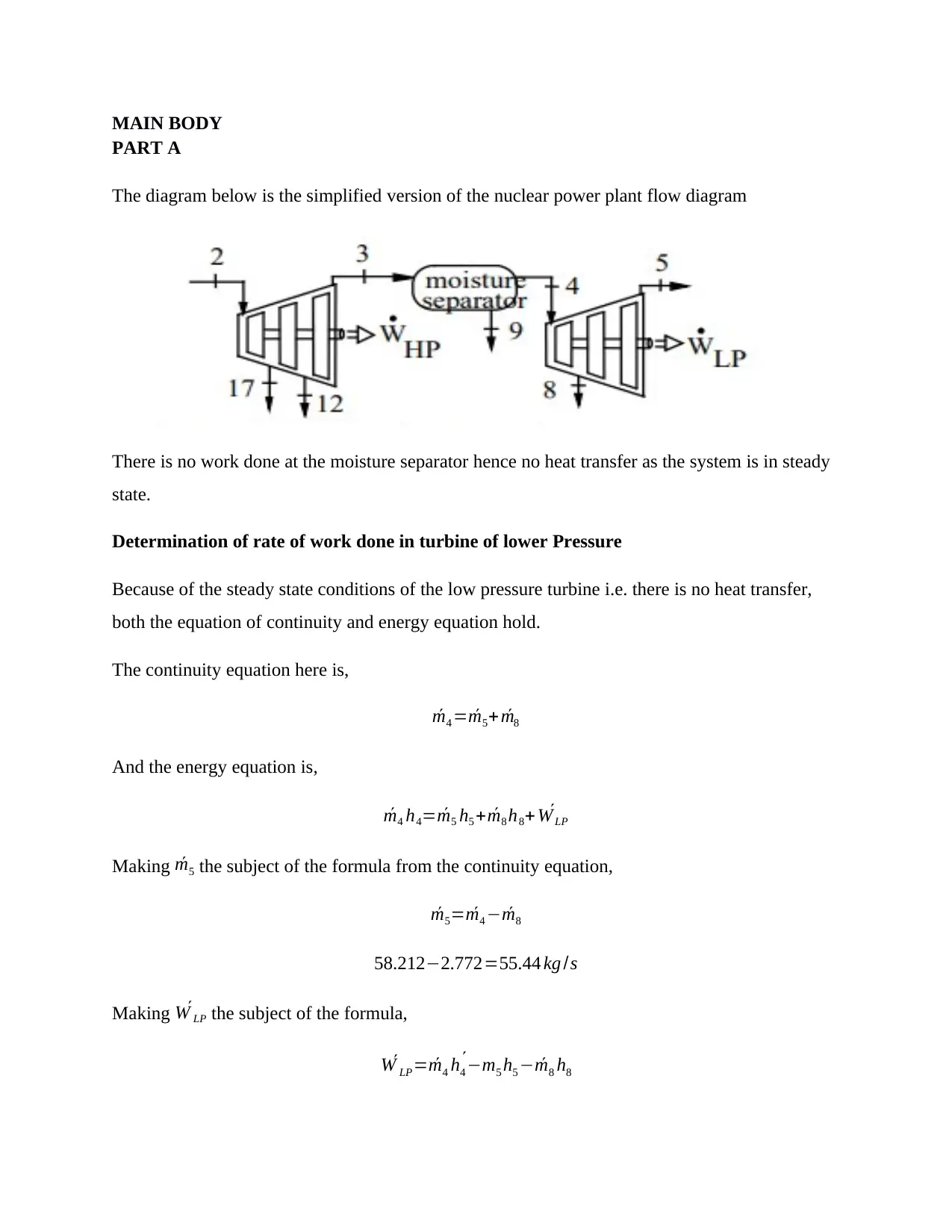
MAIN BODY
PART A
The diagram below is the simplified version of the nuclear power plant flow diagram
There is no work done at the moisture separator hence no heat transfer as the system is in steady
state.
Determination of rate of work done in turbine of lower Pressure
Because of the steady state conditions of the low pressure turbine i.e. there is no heat transfer,
both the equation of continuity and energy equation hold.
The continuity equation here is,
´m4 = ´m5+ ´m8
And the energy equation is,
´m4 h4= ´m5 h5 + ´m8 h8+ ´W LP
Making ´m5 the subject of the formula from the continuity equation,
´m5= ´m4 − ´m8
58.212−2.772=55.44 kg /s
Making ´W LP the subject of the formula,
´W LP= ´´m4 h4 −m5 h5 − ´m8 h8
PART A
The diagram below is the simplified version of the nuclear power plant flow diagram
There is no work done at the moisture separator hence no heat transfer as the system is in steady
state.
Determination of rate of work done in turbine of lower Pressure
Because of the steady state conditions of the low pressure turbine i.e. there is no heat transfer,
both the equation of continuity and energy equation hold.
The continuity equation here is,
´m4 = ´m5+ ´m8
And the energy equation is,
´m4 h4= ´m5 h5 + ´m8 h8+ ´W LP
Making ´m5 the subject of the formula from the continuity equation,
´m5= ´m4 − ´m8
58.212−2.772=55.44 kg /s
Making ´W LP the subject of the formula,
´W LP= ´´m4 h4 −m5 h5 − ´m8 h8
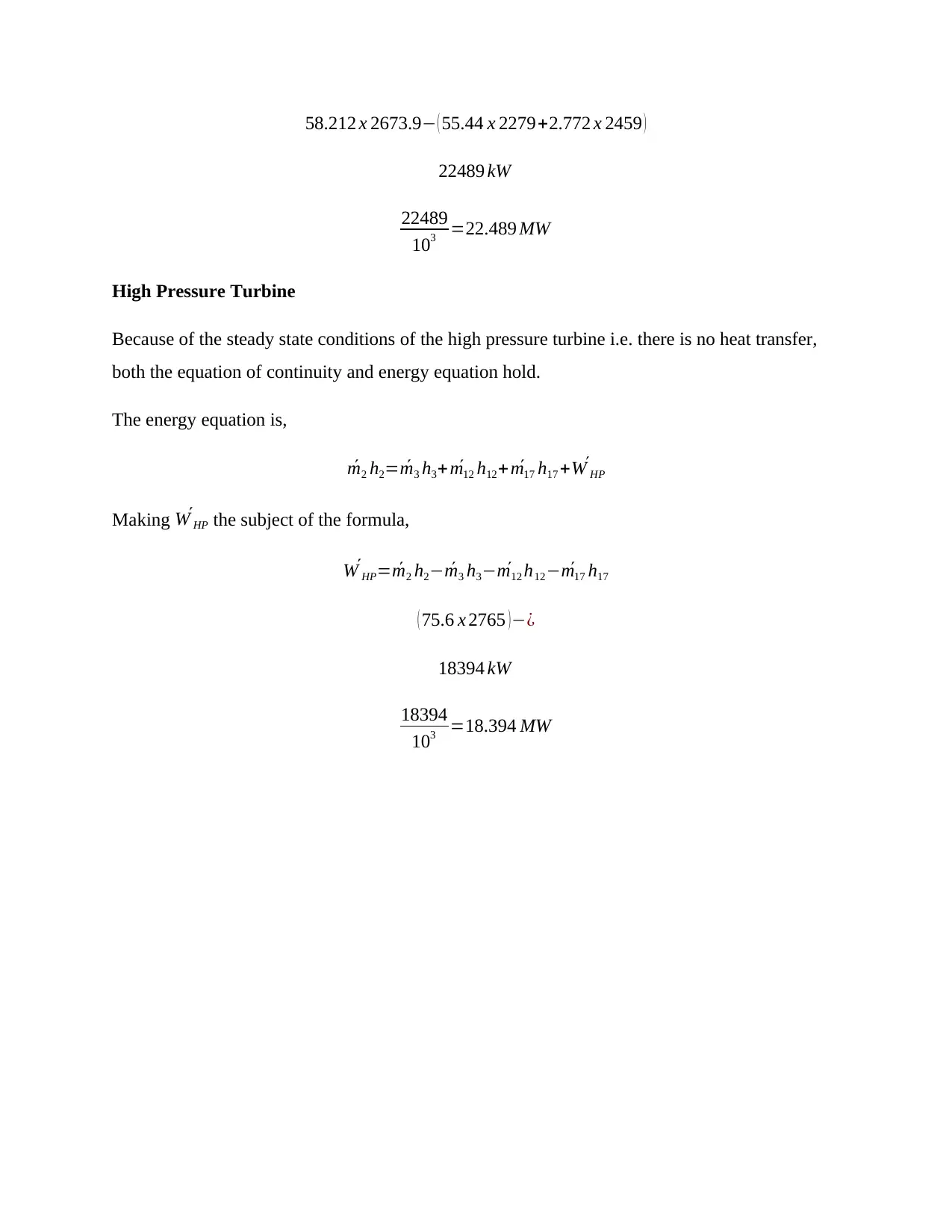
58.212 x 2673.9− ( 55.44 x 2279+2.772 x 2459 )
22489 kW
22489
103 =22.489 MW
High Pressure Turbine
Because of the steady state conditions of the high pressure turbine i.e. there is no heat transfer,
both the equation of continuity and energy equation hold.
The energy equation is,
´m2 h2= ´m3 h3+ ´m12 h12+ ´m17 h17 + ´W HP
Making ´W HP the subject of the formula,
´W HP= ´m2 h2− ´m3 h3− ´m12 h12− ´m17 h17
( 75.6 x 2765 )−¿
18394 kW
18394
103 =18.394 MW
22489 kW
22489
103 =22.489 MW
High Pressure Turbine
Because of the steady state conditions of the high pressure turbine i.e. there is no heat transfer,
both the equation of continuity and energy equation hold.
The energy equation is,
´m2 h2= ´m3 h3+ ´m12 h12+ ´m17 h17 + ´W HP
Making ´W HP the subject of the formula,
´W HP= ´m2 h2− ´m3 h3− ´m12 h12− ´m17 h17
( 75.6 x 2765 )−¿
18394 kW
18394
103 =18.394 MW
⊘ This is a preview!⊘
Do you want full access?
Subscribe today to unlock all pages.

Trusted by 1+ million students worldwide

Graphical Results
Paraphrase This Document
Need a fresh take? Get an instant paraphrase of this document with our AI Paraphraser
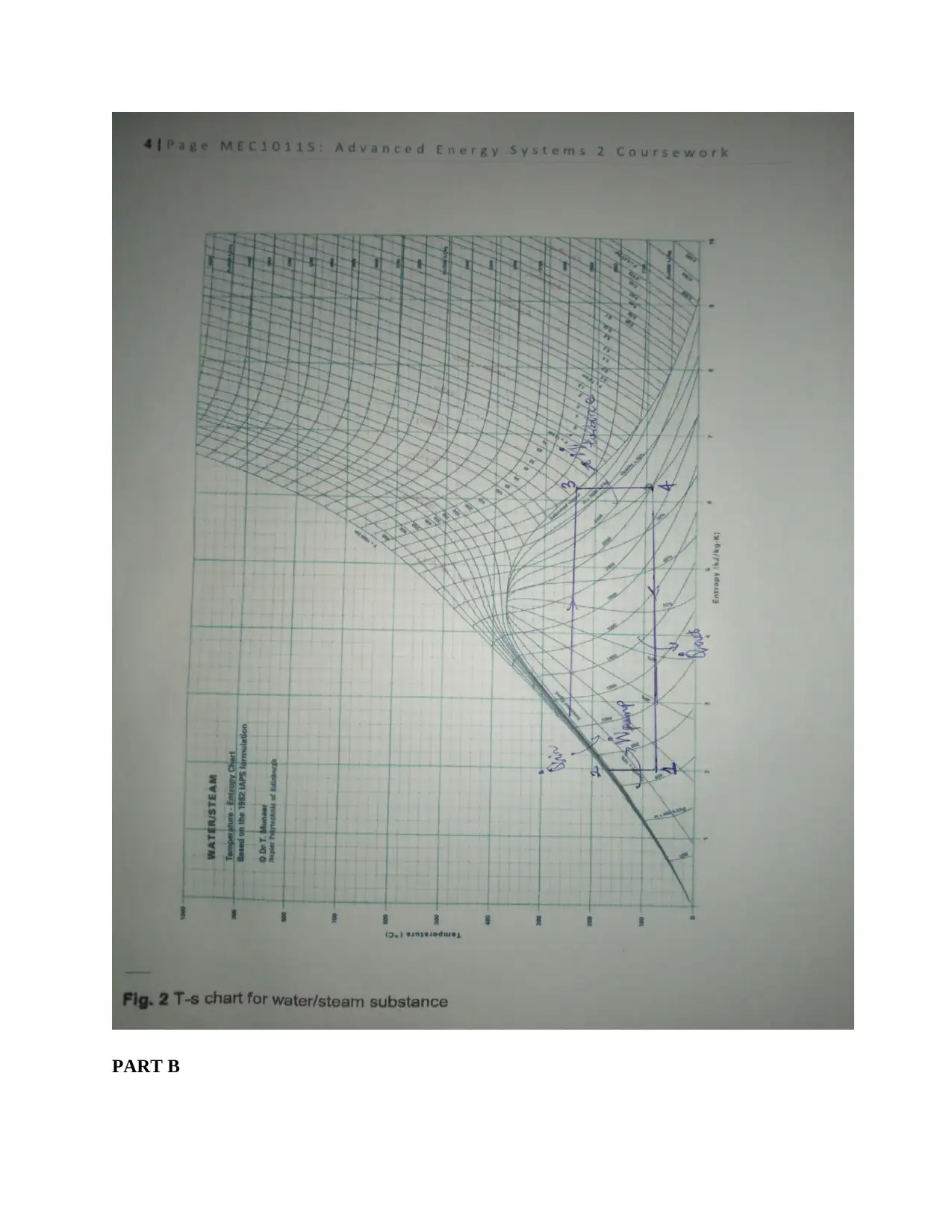
PART B
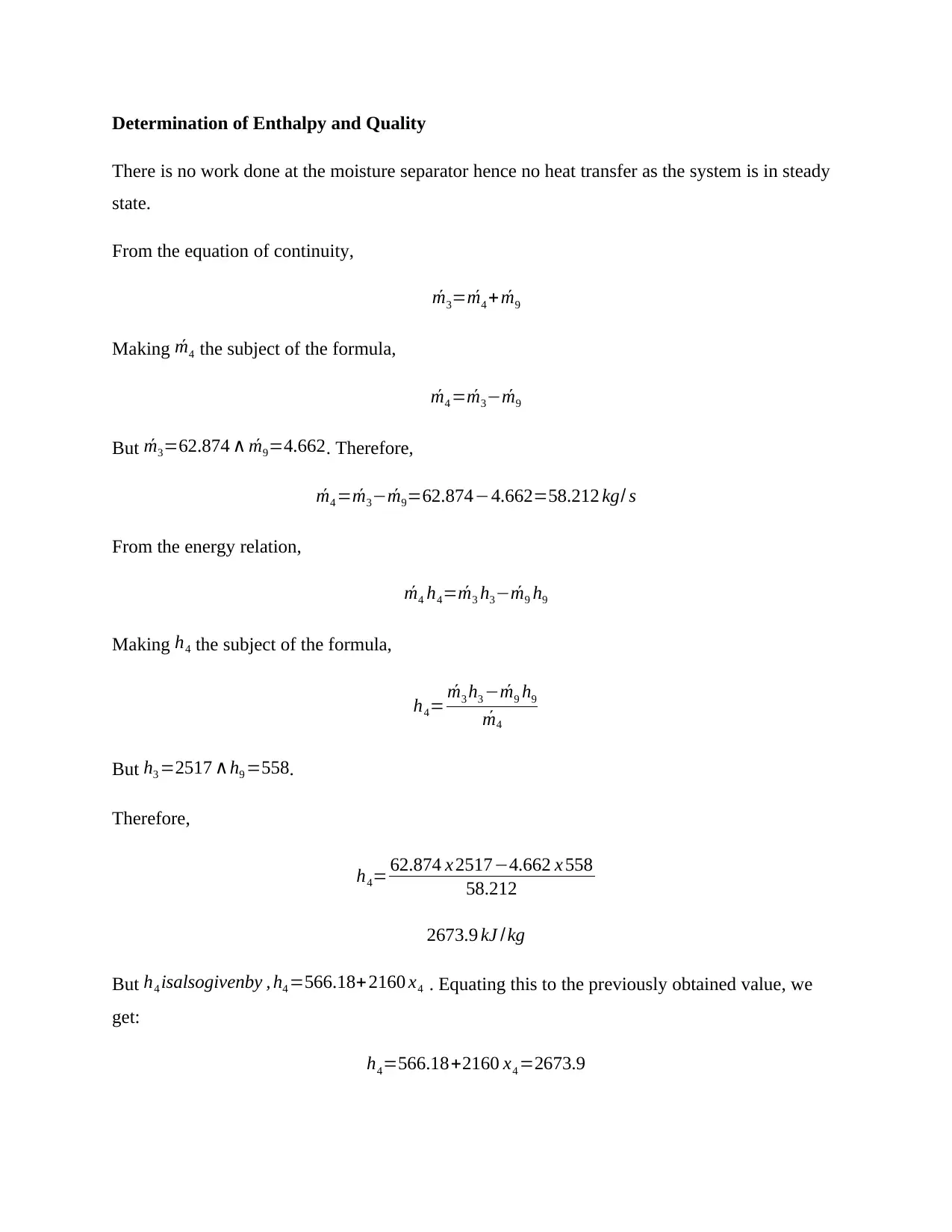
Determination of Enthalpy and Quality
There is no work done at the moisture separator hence no heat transfer as the system is in steady
state.
From the equation of continuity,
´m3= ´m4 + ´m9
Making ´m4 the subject of the formula,
´m4 = ´m3− ´m9
But ´m3=62.874 ∧ ´m9=4.662. Therefore,
´m4 = ´m3− ´m9=62.874−4.662=58.212 kg/ s
From the energy relation,
´m4 h4= ´m3 h3− ´m9 h9
Making h4 the subject of the formula,
h4= ´m3 h3 − ´m9 h9
´m4
But h3 =2517 ∧h9 =558.
Therefore,
h4= 62.874 x 2517−4.662 x 558
58.212
2673.9 kJ /kg
But h4 isalsogivenby , h4 =566.18+2160 x4 . Equating this to the previously obtained value, we
get:
h4=566.18+2160 x4 =2673.9
There is no work done at the moisture separator hence no heat transfer as the system is in steady
state.
From the equation of continuity,
´m3= ´m4 + ´m9
Making ´m4 the subject of the formula,
´m4 = ´m3− ´m9
But ´m3=62.874 ∧ ´m9=4.662. Therefore,
´m4 = ´m3− ´m9=62.874−4.662=58.212 kg/ s
From the energy relation,
´m4 h4= ´m3 h3− ´m9 h9
Making h4 the subject of the formula,
h4= ´m3 h3 − ´m9 h9
´m4
But h3 =2517 ∧h9 =558.
Therefore,
h4= 62.874 x 2517−4.662 x 558
58.212
2673.9 kJ /kg
But h4 isalsogivenby , h4 =566.18+2160 x4 . Equating this to the previously obtained value, we
get:
h4=566.18+2160 x4 =2673.9
⊘ This is a preview!⊘
Do you want full access?
Subscribe today to unlock all pages.

Trusted by 1+ million students worldwide
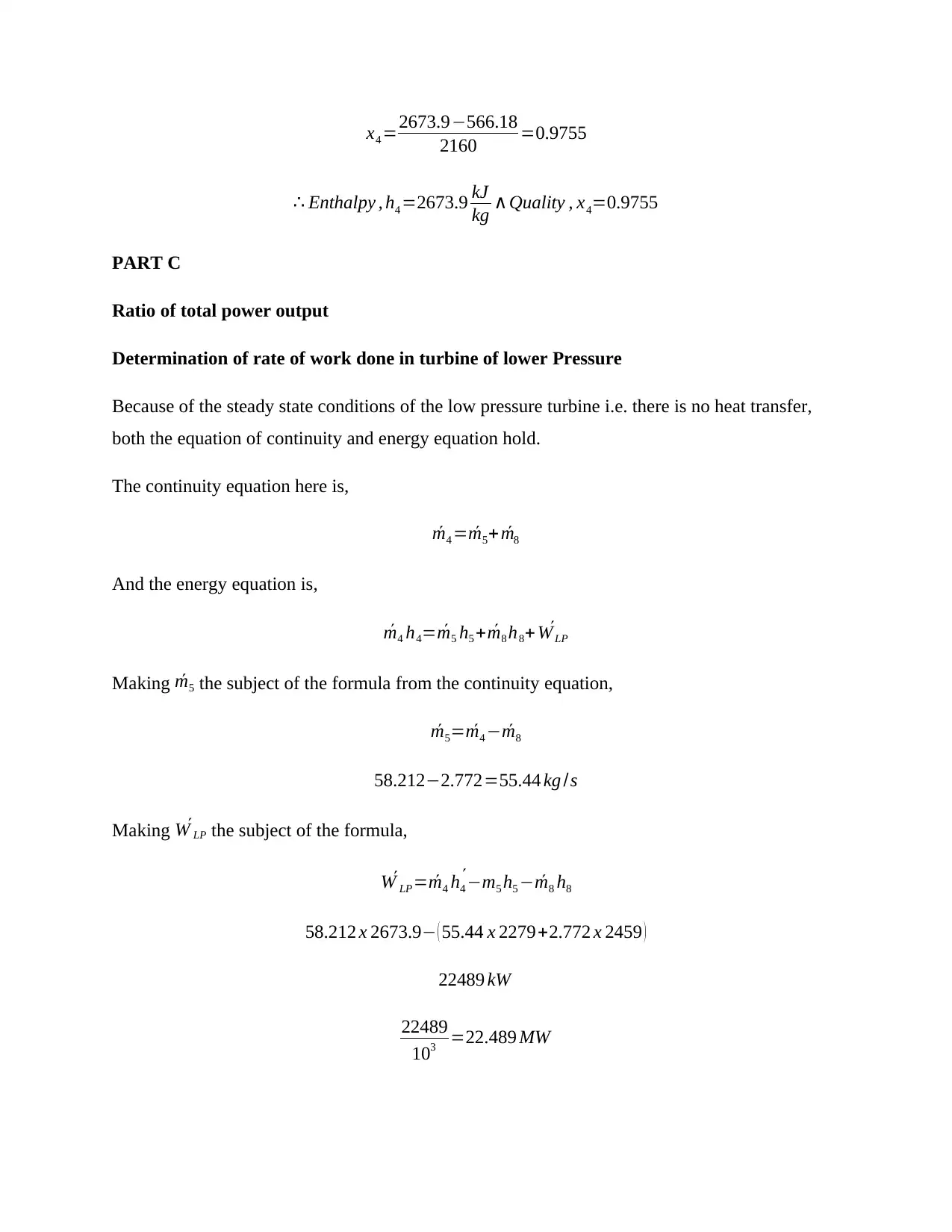
x4 =2673.9−566.18
2160 =0.9755
∴ Enthalpy , h4 =2673.9 kJ
kg ∧Quality , x4=0.9755
PART C
Ratio of total power output
Determination of rate of work done in turbine of lower Pressure
Because of the steady state conditions of the low pressure turbine i.e. there is no heat transfer,
both the equation of continuity and energy equation hold.
The continuity equation here is,
´m4 = ´m5+ ´m8
And the energy equation is,
´m4 h4= ´m5 h5 + ´m8 h8+ ´W LP
Making ´m5 the subject of the formula from the continuity equation,
´m5= ´m4 − ´m8
58.212−2.772=55.44 kg /s
Making ´W LP the subject of the formula,
´W LP= ´´m4 h4 −m5 h5 − ´m8 h8
58.212 x 2673.9− ( 55.44 x 2279+2.772 x 2459 )
22489 kW
22489
103 =22.489 MW
2160 =0.9755
∴ Enthalpy , h4 =2673.9 kJ
kg ∧Quality , x4=0.9755
PART C
Ratio of total power output
Determination of rate of work done in turbine of lower Pressure
Because of the steady state conditions of the low pressure turbine i.e. there is no heat transfer,
both the equation of continuity and energy equation hold.
The continuity equation here is,
´m4 = ´m5+ ´m8
And the energy equation is,
´m4 h4= ´m5 h5 + ´m8 h8+ ´W LP
Making ´m5 the subject of the formula from the continuity equation,
´m5= ´m4 − ´m8
58.212−2.772=55.44 kg /s
Making ´W LP the subject of the formula,
´W LP= ´´m4 h4 −m5 h5 − ´m8 h8
58.212 x 2673.9− ( 55.44 x 2279+2.772 x 2459 )
22489 kW
22489
103 =22.489 MW
Paraphrase This Document
Need a fresh take? Get an instant paraphrase of this document with our AI Paraphraser
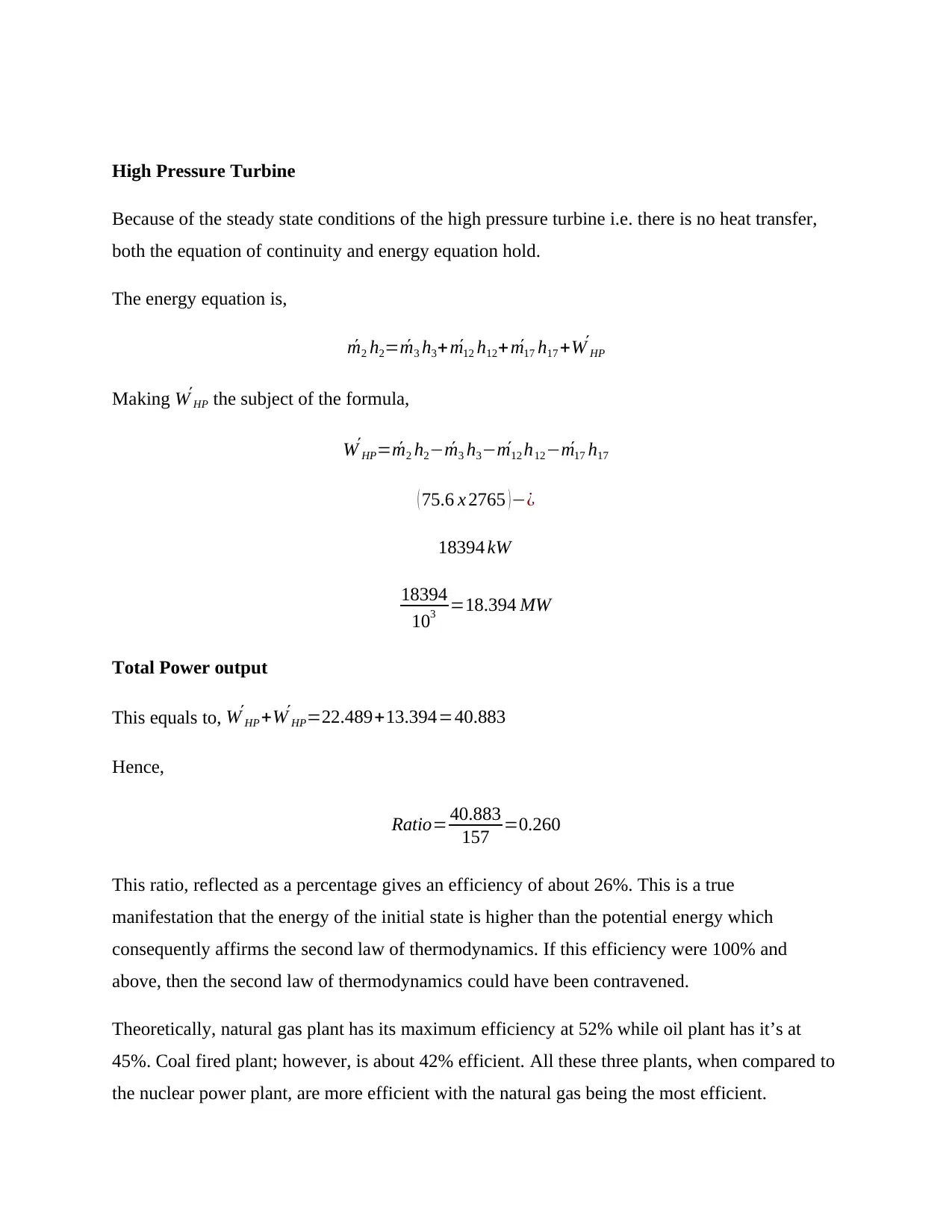
High Pressure Turbine
Because of the steady state conditions of the high pressure turbine i.e. there is no heat transfer,
both the equation of continuity and energy equation hold.
The energy equation is,
´m2 h2= ´m3 h3+ ´m12 h12+ ´m17 h17 + ´W HP
Making ´W HP the subject of the formula,
´W HP= ´m2 h2− ´m3 h3− ´m12 h12− ´m17 h17
( 75.6 x 2765 )−¿
18394 kW
18394
103 =18.394 MW
Total Power output
This equals to, ´W HP + ´W HP=22.489+13.394=40.883
Hence,
Ratio= 40.883
157 =0.260
This ratio, reflected as a percentage gives an efficiency of about 26%. This is a true
manifestation that the energy of the initial state is higher than the potential energy which
consequently affirms the second law of thermodynamics. If this efficiency were 100% and
above, then the second law of thermodynamics could have been contravened.
Theoretically, natural gas plant has its maximum efficiency at 52% while oil plant has it’s at
45%. Coal fired plant; however, is about 42% efficient. All these three plants, when compared to
the nuclear power plant, are more efficient with the natural gas being the most efficient.
Because of the steady state conditions of the high pressure turbine i.e. there is no heat transfer,
both the equation of continuity and energy equation hold.
The energy equation is,
´m2 h2= ´m3 h3+ ´m12 h12+ ´m17 h17 + ´W HP
Making ´W HP the subject of the formula,
´W HP= ´m2 h2− ´m3 h3− ´m12 h12− ´m17 h17
( 75.6 x 2765 )−¿
18394 kW
18394
103 =18.394 MW
Total Power output
This equals to, ´W HP + ´W HP=22.489+13.394=40.883
Hence,
Ratio= 40.883
157 =0.260
This ratio, reflected as a percentage gives an efficiency of about 26%. This is a true
manifestation that the energy of the initial state is higher than the potential energy which
consequently affirms the second law of thermodynamics. If this efficiency were 100% and
above, then the second law of thermodynamics could have been contravened.
Theoretically, natural gas plant has its maximum efficiency at 52% while oil plant has it’s at
45%. Coal fired plant; however, is about 42% efficient. All these three plants, when compared to
the nuclear power plant, are more efficient with the natural gas being the most efficient.
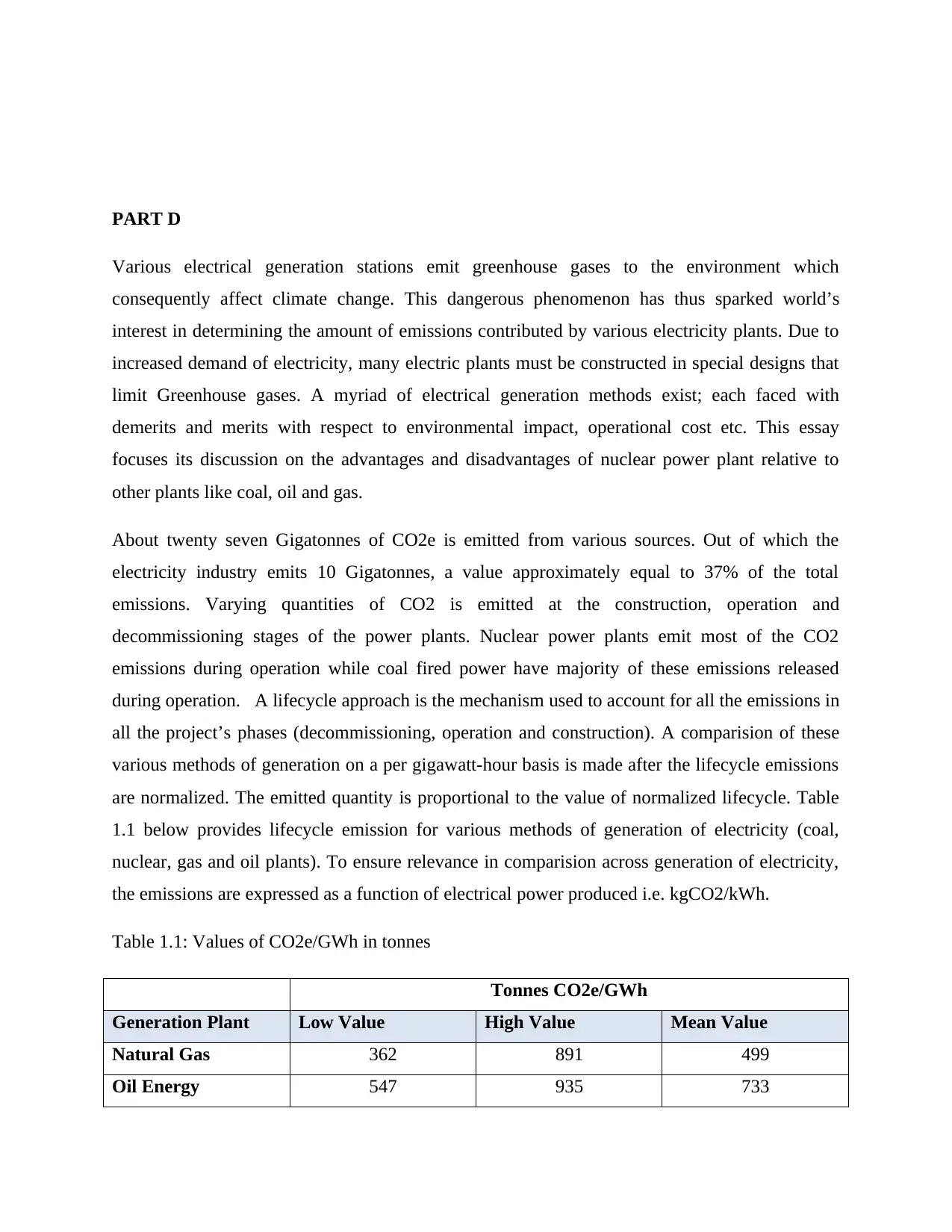
PART D
Various electrical generation stations emit greenhouse gases to the environment which
consequently affect climate change. This dangerous phenomenon has thus sparked world’s
interest in determining the amount of emissions contributed by various electricity plants. Due to
increased demand of electricity, many electric plants must be constructed in special designs that
limit Greenhouse gases. A myriad of electrical generation methods exist; each faced with
demerits and merits with respect to environmental impact, operational cost etc. This essay
focuses its discussion on the advantages and disadvantages of nuclear power plant relative to
other plants like coal, oil and gas.
About twenty seven Gigatonnes of CO2e is emitted from various sources. Out of which the
electricity industry emits 10 Gigatonnes, a value approximately equal to 37% of the total
emissions. Varying quantities of CO2 is emitted at the construction, operation and
decommissioning stages of the power plants. Nuclear power plants emit most of the CO2
emissions during operation while coal fired power have majority of these emissions released
during operation. A lifecycle approach is the mechanism used to account for all the emissions in
all the project’s phases (decommissioning, operation and construction). A comparision of these
various methods of generation on a per gigawatt-hour basis is made after the lifecycle emissions
are normalized. The emitted quantity is proportional to the value of normalized lifecycle. Table
1.1 below provides lifecycle emission for various methods of generation of electricity (coal,
nuclear, gas and oil plants). To ensure relevance in comparision across generation of electricity,
the emissions are expressed as a function of electrical power produced i.e. kgCO2/kWh.
Table 1.1: Values of CO2e/GWh in tonnes
Tonnes CO2e/GWh
Generation Plant Low Value High Value Mean Value
Natural Gas 362 891 499
Oil Energy 547 935 733
Various electrical generation stations emit greenhouse gases to the environment which
consequently affect climate change. This dangerous phenomenon has thus sparked world’s
interest in determining the amount of emissions contributed by various electricity plants. Due to
increased demand of electricity, many electric plants must be constructed in special designs that
limit Greenhouse gases. A myriad of electrical generation methods exist; each faced with
demerits and merits with respect to environmental impact, operational cost etc. This essay
focuses its discussion on the advantages and disadvantages of nuclear power plant relative to
other plants like coal, oil and gas.
About twenty seven Gigatonnes of CO2e is emitted from various sources. Out of which the
electricity industry emits 10 Gigatonnes, a value approximately equal to 37% of the total
emissions. Varying quantities of CO2 is emitted at the construction, operation and
decommissioning stages of the power plants. Nuclear power plants emit most of the CO2
emissions during operation while coal fired power have majority of these emissions released
during operation. A lifecycle approach is the mechanism used to account for all the emissions in
all the project’s phases (decommissioning, operation and construction). A comparision of these
various methods of generation on a per gigawatt-hour basis is made after the lifecycle emissions
are normalized. The emitted quantity is proportional to the value of normalized lifecycle. Table
1.1 below provides lifecycle emission for various methods of generation of electricity (coal,
nuclear, gas and oil plants). To ensure relevance in comparision across generation of electricity,
the emissions are expressed as a function of electrical power produced i.e. kgCO2/kWh.
Table 1.1: Values of CO2e/GWh in tonnes
Tonnes CO2e/GWh
Generation Plant Low Value High Value Mean Value
Natural Gas 362 891 499
Oil Energy 547 935 733
⊘ This is a preview!⊘
Do you want full access?
Subscribe today to unlock all pages.

Trusted by 1+ million students worldwide
1 out of 17
Your All-in-One AI-Powered Toolkit for Academic Success.
+13062052269
info@desklib.com
Available 24*7 on WhatsApp / Email
![[object Object]](/_next/static/media/star-bottom.7253800d.svg)
Unlock your academic potential
Copyright © 2020–2025 A2Z Services. All Rights Reserved. Developed and managed by ZUCOL.


